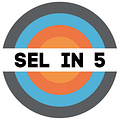This month, we learn about academic resilience, modeling the standard, and fostering a culture of support in schools. We hope you are enjoying 2023 so far!
3 SEL Leadership Thoughts
Model the standard.
People gravitate toward the standard you set, *not* the standard you request.
Model how to work and how to treat others; model the act of falling in love with the process; model the actions that create safe, supportive, and equitable environments. [Tweet This]
—
It’s critical to differentiate between foundational learning and professional learning when it comes to SEL. Foundational learning is for everyone in the school community and should come before specialized professional learning. In foundational learning, it is important to answer: what is SEL, why is it important (for students and for adults), how can SEL positively impact outcomes for students, what the role of educators is in supporting students’ SEL, and how is SEL promoted (in classrooms, schools, and within the family and community)? From there, we can shift from the basics to more specialized opportunities for educators to connect, reflect, and support each other with the nuances of SEL implementation.
In providing ongoing opportunities for specialized professional learning, educators will problem-solve together and organically overcome unforeseen challenges. [Tweet This]
—
Academic resilience, or our ability to see ourselves as capable of learning after hardships, is a concept that is not talked about nearly enough. But it is a perfect example of why we need to embody the “BOTH/AND” mindset when it comes to SEL and academics. Academic resilience is not a fixed quality; it depends on the attitudes we are encouraged to have about learning.
Through providing students more voice and choice, we can help them tailor their goals to their interests and individual needs. We know from the research that while students’ sense of belonging increased during the pandemic, their self-efficacy decreased. Focusing on academic resilience can help us counteract this. [Tweet This]
2 Quotes from SEL Leaders
“When we normalize teaching problems, we foster a culture in which teachers are less anxious, have greater self-efficacy, and feel more supported in their professional growth.” – Indu Chugani Singh
—
“Every child is an artist. The problem is how to remain an artist once he grows up.” – Pablo Picasso
1 Question to Reflect On
Why do we implement interventions? What is the purpose?
—
If you enjoyed that, please consider sharing SEL in 5 with others.
Until next month,
Nick Woolf
Author of SEL in 5
Founder of Inside SEL
p.s. here’s what else I’m reading:

